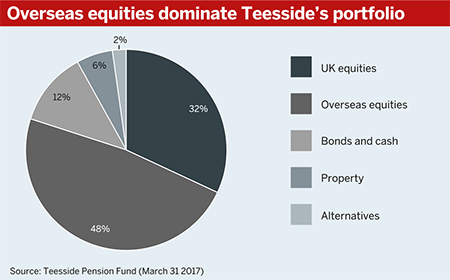The £3.9bn Middlesbrough Borough Council Teesside Pension Fund has invested in operational grid-scale energy storage assets, through the British Strategic Investment Fund.
BSIF, managed by asset manager Gresham House, held its first close in 2017 with £150m of commitments placed by institutional investors, including Local Government Pension Schemes.
An investment of £30m or £40m in a particular infrastructure is actually below scale for what pools are looking for
Nick Buckland, JLT Employee Benefits
The values of the BSIF investment, and Teesside’s stake, are undisclosed. Sites in Nottinghamshire, Bristol and Essex with a combination of 30 megawatts in storage assets will be the beneficiaries of the investment.
The Teesside fund has invested £40m in BSIF, and is participating alongside the £1.9bn Royal County of Berkshire Pension Fund, which took a 20 per cent stake in Gresham House in early 2017.
The project takes place in advance of local government pooling plans, which will see the assets of all local authority pension schemes and the Environment Agency Pension Fund moved into eight pools.
Included in the objectives of pooling is the intention to facilitate greater levels of infrastructure spending.
Paul Campbell, head of investments and treasury management at the Teesside scheme, said the fund did not want to miss out on alternative investments in the lead-up to pooling.
“Pooling eventually will come along and there’ll be a solution for the pool for alternative investment, but as the pool is in the process of developing, it seems unwise for us to just halt things and not continue with investments up until that point [where] it’s ready,” he said.
Campbell said the project suited the fund’s drive to diversify across the energy sector. The scheme has listed energy investments, but these tend to be in the fossil fuel space.
“Energy storage just kind of logically fitted with where we are in that energy sector at the moment,” he added.
Tony Dalwood, Gresham House chief executive, said there is an opportunity for schemes to exploit an illiquidity premium through these investments.
He said there was recognition that the real assets space can “allow pension schemes particularly to pick up illiquidity discount value assets which... provide a longer-term superior return”.

Smaller infrastructure threatened
One perhaps unintended outcome from LGPS pooling might be the restriction of infrastructure investment to larger-scale projects. This would come to the detriment of smaller infrastructure that might be unable to provide sufficient yield to the pools.
Nick Buckland, senior investment consultant at JLT Employee Benefits, said: “For [pools], an investment of £30m or £40m in a particular infrastructure, which may be a really good investment, is actually below scale for what they’re looking for.”
Buckland said he is concerned for the prospects of “niche, boutique investment managers” who might “miss out” owing to a shift in bias towards larger scale investments.
Leverage can undermine inflation linkage
Interest in alternatives has surged over the past 20 years. According to research by UBS, in 1997 the average UK pension fund held just 1 per cent of its portfolio in alternatives. In the first quarter of 2016 this stood at 9 per cent.
Recently, the South Yorkshire Pension Fund lowered its allocation to equities in favour of alternatives.
Matthew Simms, director at consultancy P-Solve, said that although he had not seen many schemes making this kind of alternative investment, he saw the virtues of the project.
“It’s probably got some inflation linkage in there… long-term-type cash flows, that’s what infrastructure has generally got going for it,” he said.
Infrastructure investment is not without its drawbacks. Simms identified the opportunity cost borne by committing cash at a potentially unfavourable pricing point. He also highlighted the risk associated with using leverage for infrastructure funding.
“If you’re wanting to buy an asset for the nice inflation-linked cash flows, and then you add a lot of leverage to it, it can kind of wash away that inflation linkage, because what your return is being driven by is all of that leverage backing it up,” he said.
South Yorks plumps for alts as equity concerns bite
The South Yorkshire Pension Fund is trimming its equity exposure and allocating to a range of alternatives, as part of a wide-ranging review that reaffirms the fund’s commitment to environmental, social and governance-based principles.
The success of the investment “depends on which way interest rates are moving and how that leverage is impacting your investment, rather than the thing you were trying to buy at the start,” he added.
BSIF has funded its energy investment via a combination of senior cash-paid loan notes and equity in a dedicated project company.














